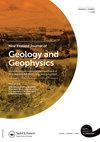新西兰北坎特伯雷鸸鹋平原西驼峰断层的古地震活动性
IF 1.9
4区 地球科学
Q1 GEOLOGY
New Zealand Journal of Geology and Geophysics
Pub Date : 2021-11-03
DOI:10.1080/00288306.2021.1986727
引用次数: 6
摘要
摘要:2016年凯库拉7.8兆瓦地震以驼峰断层为核,该断层在坎特伯雷北部的埃穆平原断裂。在2016年地震之前,断层的古地震历史受到了很差的约束。为了确定断层上地震的时间和单次事件位移(SED),我们使用了光学激发发光(OSL)和断层地层学的放射性碳年代,以及McLean-1海沟现场断层(即几何结构和滑动)的分析。在海沟处,断层走向为东西走向,主要适应2016年的右侧走滑(2 ± 0.2 m走滑和0.35 ± 0.05 m垂直滑动北侧下降)。Humps断层的地震活动比以前认为的要活跃,在至少六次地表破裂的古地震中发生了滑动。这些地震发生的时间为:9.8–15.3 ka BP(事件1),8.6–11.5 ka BP(事件2),8.1–10.9 ka BP(事件3),6.0–8.6 ka BP(事件4),公元1840年至4.5年 ka(事件5)和2016 AD(事件6)。这些地震的平均重现期为1.8-3.4 kyr,复发间隔可达~9 kyr。Kaikōura型破裂的频率可能高达每2次 kyr,如果驼峰断层破裂几何形状不是特征性的,则可能更长。本文章由计算机程序翻译,如有差异,请以英文原文为准。
Paleoseismicity of the western Humps fault on the Emu Plain, North Canterbury, New Zealand
ABSTRACT The 2016 MW 7.8 Kaikōura Earthquake nucleated on The Humps fault, which ruptured across the Emu Plain in North Canterbury. The paleoearthquake history of the fault was poorly constrained prior to the 2016 earthquake. To determine the timing and single-event displacements (SED) of earthquakes on the fault we use Optically Stimulated Luminescence (OSL) and radiocarbon dates of faulted stratigraphy and analysis of faulting (i.e. geometry and slip) at the McLean-1 trench site. At the trench the fault trace trends east–west and primarily accommodated right-lateral strike-slip in 2016 (2 ± 0.2 m strike slip and 0.35 ± 0.05 m vertical slip northside downthrow). The Humps fault is more seismically active than previously thought and accrued slip during at least six surface rupturing paleoearthquakes. The timing of these earthquakes was: 9.8–15.3 ka BP (Event 1), 8.6–11.5 ka BP (Event 2), 8.1–10.9 ka BP (Event 3), 6.0–8.6 ka BP (Event 4), 1840 AD to 4.5 ka (Event 5), and 2016 AD (Event 6). These earthquakes have a mean recurrence interval of 1.8–3.4 kyr and could have recurrence intervals up to ~9 kyr. Kaikōura-type ruptures could occur as frequently as every ∼2 kyr and maybe longer if The Humps fault rupture geometries are not characteristic.
求助全文
通过发布文献求助,成功后即可免费获取论文全文。
去求助
来源期刊
CiteScore
5.10
自引率
27.30%
发文量
34
审稿时长
>12 weeks
期刊介绍:
Aims: New Zealand is well respected for its growing research activity in the geosciences, particularly in circum-Pacific earth science. The New Zealand Journal of Geology and Geophysics plays an important role in disseminating field-based, experimental, and theoretical research to geoscientists with interests both within and beyond the circum-Pacific. Scope of submissions: The New Zealand Journal of Geology and Geophysics publishes original research papers, review papers, short communications and letters. We welcome submissions on all aspects of the earth sciences relevant to New Zealand, the Pacific Rim, and Antarctica. The subject matter includes geology, geophysics, physical geography and pedology.

 求助内容:
求助内容: 应助结果提醒方式:
应助结果提醒方式:


